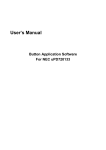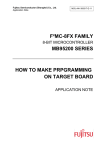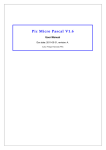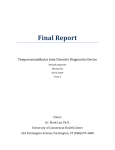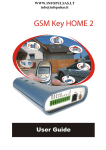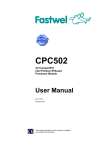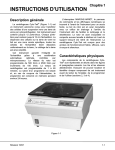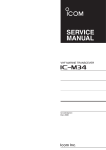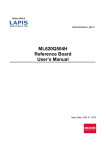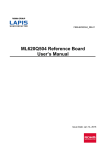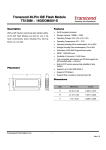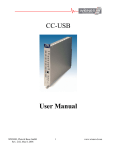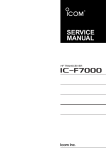Download ET-0170 uPD720133 (USB2.0 to IDE Bridge) Evaluation
Transcript
Preliminary User’s Manual ET-0170 µPD720133 (USB2.0 to IDE Bridge) Evaluation Board Document No. S17123EJ1V0UM00 (1st edition) Date Published March 2004 NS CP (N) 2004 Printed in Japan [MEMO] 2 Preliminary User's Manual S17123EJ1V0UM NOTES FOR CMOS DEVICES 1 VOLTAGE APPLICATION WAVEFORM AT INPUT PIN Waveform distortion due to input noise or a reflected wave may cause malfunction. If the input of the CMOS device stays in the area between VIL (MAX) and VIH (MIN) due to noise, etc., the device may malfunction. Take care to prevent chattering noise from entering the device when the input level is fixed, and also in the transition period when the input level passes through the area between VIL (MAX) and VIH (MIN). 2 HANDLING OF UNUSED INPUT PINS Unconnected CMOS device inputs can be cause of malfunction. If an input pin is unconnected, it is possible that an internal input level may be generated due to noise, etc., causing malfunction. CMOS devices behave differently than Bipolar or NMOS devices. Input levels of CMOS devices must be fixed high or low by using pull-up or pull-down circuitry. Each unused pin should be connected to VDD or GND via a resistor if there is a possibility that it will be an output pin. All handling related to unused pins must be judged separately for each device and according to related specifications governing the device. 3 PRECAUTION AGAINST ESD A strong electric field, when exposed to a MOS device, can cause destruction of the gate oxide and ultimately degrade the device operation. Steps must be taken to stop generation of static electricity as much as possible, and quickly dissipate it when it has occurred. Environmental control must be adequate. When it is dry, a humidifier should be used. It is recommended to avoid using insulators that easily build up static electricity. Semiconductor devices must be stored and transported in an anti-static container, static shielding bag or conductive material. All test and measurement tools including work benches and floors should be grounded. The operator should be grounded using a wrist strap. Semiconductor devices must not be touched with bare hands. Similar precautions need to be taken for PW boards with mounted semiconductor devices. 4 STATUS BEFORE INITIALIZATION Power-on does not necessarily define the initial status of a MOS device. Immediately after the power source is turned ON, devices with reset functions have not yet been initialized. Hence, power-on does not guarantee output pin levels, I/O settings or contents of registers. A device is not initialized until the reset signal is received. A reset operation must be executed immediately after power-on for devices with reset functions. Preliminary User's Manual S17123EJ1V0UM 3 USB logo is a trademark of USB Implementers Forum, Inc. Windows is either a registered trademark or a trademark of Microsoft Corporation in the United States and/or other countries. • The information contained in this document is being issued in advance of the production cycle for the product. The parameters for the product may change before final production or NEC Electronics Corporation, at its own discretion, may withdraw the product prior to its production. • No part of this document may be copied or reproduced in any form or by any means without prior written consent of NEC Electronics. NEC Electronics assumes no responsibility for any errors that may appear in this document. • NEC Electronics does not assume any liability for infringement of patents, copyrights or other intellectual property rights of third parties by or arising from the use of NEC Electronics products listed in this document or any other liability arising from the use of such NEC Electronics products. No license, express, implied or otherwise, is granted under any patents, copyrights or other intellectual property rights of NEC Electronics or others. • Descriptions of circuits, software and other related information in this document are provided for illustrative purposes in semiconductor product operation and application examples. The incorporation of these circuits, software and information in the design of customer's equipment shall be done under the full responsibility of customer. NEC Electronics assumes no responsibility for any losses incurred by customers or third parties arising from the use of these circuits, software and information. M5A 02. 11 4 Preliminary User's Manual S17123EJ1V0UM INTRODUCTION Readers This manual is intended for engineers who will test USB2.0 to IDE bridge system by using the ET-0170. Purpose This manual explains the functions of the ET-0170 in the following arrangements. Arrangement This manual includes the following chapters. • • • • • • How to Read This Manual Overview Usage of the ET-0170 Parts information Reference for connection The ET-0170 board information The reference schematic It is assumed that the readers of this manual have general knowledge of electricity, logic circuits, USB specification, USB mass storage class specification, and AT Attachment with Packet Interface-6 (ATA/ATAPI-6) specification. Conventions Data significance: Higher significant digits on the left and lower significant digits on the right Active low representation: xxxB (B suffixed to pin name or signal name) Note: Footnote for item marked with Note in the text Caution: Information requiring particular attention Remark: Supplementary information Numeric notation: Binary … xxxx or xxxxB Decimal … xxxx Hexadecimal … xxxxH Related Documents The related documents indicated in this document may include preliminary versions. • µPD720133 Data Sheet: To be released soon • µPD720133 User’s Manual: To be released soon • µPD720133 Application Note Serial ROM Utility: To be released soon • Universal Serial Bus Specification 2.0 • Universal Serial Bus Mass Storage Class Specification Overview (Including documents listed in the Overview) • AT Attachment with Packet Interface-6 (ATA/ATAPI-6) specification Be sure to read the latest version of the above documents when using the ET-0170. Version History No. 1 Version ET-0170 (FB-2471A) Description st 1 Version Details in difference are described in this manual. Preliminary User's Manual S17123EJ1V0UM 5 CONTENTS CHAPTER 1 OVERVIEW...........................................................................................................................8 1.1 Features ........................................................................................................................................8 1.2 Board Diagram..............................................................................................................................9 1.3 Picture of the ET-0170................................................................................................................10 CHAPTER 2 USAGE OF THE ET-0170 ...............................................................................................11 2.1 Required Items to Test IDE Bridge System with the µPD720133 ..........................................11 2.2 2.3 2.1.1 Power supply ...................................................................................................................................11 2.1.2 USB cable........................................................................................................................................11 2.1.3 PC ...................................................................................................................................................11 2.1.4 IDE device .......................................................................................................................................11 How to Setup IDE Bridge System .............................................................................................12 2.2.1 Check jumper and connector setting ...............................................................................................12 2.2.2 Board checking................................................................................................................................13 2.2.3 Connects IDE device to the ET-0170 ..............................................................................................13 2.2.4 Connects power supply to IDE device and the ET-0170..................................................................13 How to Test IDE Bridge System................................................................................................14 2.3.1 Power ON ........................................................................................................................................14 2.3.2 Connect to USB port........................................................................................................................14 2.3.3 Disconnect from USB port ...............................................................................................................14 CHAPTER 3 PARTS INFORMATION.....................................................................................................15 3.1 Parts Information........................................................................................................................15 3.1.1 µPD720133......................................................................................................................................15 3.1.2 Serial ROM Socket (U2) ..................................................................................................................17 3.1.3 Power switch (U3) ...........................................................................................................................19 3.1.4 Regulator (U4, U5) ..........................................................................................................................19 3.1.5 Oscillator (Y1)..................................................................................................................................19 3.1.6 Power supply and reset information ................................................................................................19 3.1.7 Jumper information ..........................................................................................................................19 3.1.8 Connector information .....................................................................................................................20 CHAPTER 4 REFERENCE FOR CONNECTION ..................................................................................21 4.1 USB Circuit .................................................................................................................................21 4.2 IDE Circuit ...................................................................................................................................23 4.3 Oscillator.....................................................................................................................................24 4.4 Reset Circuit ...............................................................................................................................25 4.5 VBUS Monitoring Circuit ...........................................................................................................25 4.6 Serial ROM Connection .............................................................................................................26 CHAPTER 5 THE ET-0170 BOARD INFORMATION ..........................................................................27 5.1 Schematic for ET-0170 (FB-2471A)...........................................................................................27 5.2 Parts List for ET-0170 (FB-2471A) ............................................................................................29 5.3 Board Pattern for ET-0170 (FB-2471A).....................................................................................31 6 Preliminary User's Manual S17123EJ1V0UM LIST OF FIGURES Figure No. Title Page 1-1 Board Diagram........................................................................................................................................................ 9 2-1 Jumper Setting...................................................................................................................................................... 12 3-1 Pin Configuration (Top View) ................................................................................................................................ 15 4-1 USB Data Signaling .............................................................................................................................................. 21 4-2 USB Reference Resistor....................................................................................................................................... 21 4-3 Decoupling Capacitor ........................................................................................................................................... 22 4-4 IDE Connection..................................................................................................................................................... 23 4-5 Oscillator Circuit.................................................................................................................................................... 24 4-6 Reset Reference Circuit........................................................................................................................................ 25 4-7 VBUS Monitoring Circuit ....................................................................................................................................... 25 4-8 Serial ROM Connection ........................................................................................................................................ 26 LIST OF TABLES Table No. Title Page 2-1 Jumper Setting...................................................................................................................................................... 12 3-1 Pin Information...................................................................................................................................................... 16 3-2 Serial ROM Data................................................................................................................................................... 17 3-3 DV1/DV0, CLC, PWR Setting ............................................................................................................................... 18 3-4 DV1/DV0, DCC Setting ......................................................................................................................................... 18 3-5 Power Supply and Reset Information ................................................................................................................... 19 3-6 Jumper Information............................................................................................................................................... 19 3-7 Connector Information .......................................................................................................................................... 20 Preliminary User's Manual S17123EJ1V0UM 7 CHAPTER 1 OVERVIEW This document describes the functions of the µPD720133 evaluation board ET-0170. The µPD720133 and a serial ROM are implemented on the ET-0170. This board allows quick test of different serial ROM’s data setting against the µPD720133 during prototyping. This board has been certified by USB implementers forum (TID: 10330107). 1.1 Features This section explains the main features of the ET-0170. (1) Compliant with Universal Serial Bus Specification Revision 2.0 (Data Rate 12/480 Mbps) This board has the µPD720133 which is the bus/self-powered high-speed capable device and works at 12 Mbps data rate (FS: full speed) or 480 Mbps date rate (HS: high speed). The chip µPD720133 has been certified by USB Implementers Forum and granted with USB 2.0 high-speed Logo (TID: 40320125). (2) Compliant with AT Attachment with Packet Interface-6 (ATA/ATAPI-6). The IDE controller in the µPD720133 supports PIO Mode 0-4, Multi Word DMA Mode 0-2, Ultra DMA Mode 0-4, and LBA48. The evaluation kit comes with Ultra DMA Mode 4 IDE cable. The IDE bridge system will be ready for test once IDE target device is attached. (3) Bus-powered USB2.0 to IDE bridge system The device supports bus-powered operation if the power consumption for whole USB2.0 to IDE bridge system is less than the specification for bus-powered device. The µPD720133 has some features such as power supply control signaling for IDE device. The power supply circuitry on the board uses either VBUS or external power supply for the power line connector connecting to the IDE target device. The power line connector has DPC, GND and VDD line, and it is readily for bus-powered application using the power supply circuit on board. (4) Extension for function The function of the µPD720133 is controlled by data in serial ROM. Also, It is possible to realize firmware extension by using the serial ROM. This board has a serial ROM socket for quick serial ROM replacement. 8 Preliminary User's Manual S17123EJ1V0UM CHAPTER 1 OVERVIEW 1.2 Board Diagram Figure 1-1. Board Diagram NEC uPD720133 Evaluation Board JP6 JP7 JP8 ET-0170 U2 CN1 JP2 U4 JP3 U3 CN3 JP1 JP5 JP4 U5 U1 S1 Y1 PC1 LED2 JP9 LED1 CN2 PC1 : Power line connector CN1 : USB connector CN2 : IDE connector CN3 : Power line selection connector U1 : USB to IDE bridge chip (µPD720133) U2 : Socket (Serial ROM) U3 : Regulator U4 : Regulator U5 : Power switch LED1 : Access lamp LED2 : Power LED Y1 : X’tal S1 : Reset switch JP(9:1) : Jumper Preliminary User's Manual S17123EJ1V0UM 9 CHAPTER 1 OVERVIEW 1.3 10 Picture of the ET-0170 Preliminary User's Manual S17123EJ1V0UM CHAPTER 2 2.1 USAGE OF THE ET-0170 Required Items to Test IDE Bridge System with the µPD720133 This section explains the required items to test IDE bridge system with the ET-0170. 2.1.1 Power supply The ET-0170 requires 5 V power supply. Typical ATX power supply or any other 5 V power supply is applicable. The PC1 connector on this board uses the power connector of 3.5” floppy drive (FDD). 2.1.2 USB cable A USB cable is required certifying by USB Implementers Forum as high-speed capable. If the uncertified cable is used for this system, the transaction error on USB bus may be occurred. And if any transaction error occurs on USB bus, the performance of the ET-0170 will be degraded. 2.1.3 PC It is required that PC should have a USB 2.0 Host controller on the mother board or on the PCI card plugged into PCI slot. If the IDE bridge system operates in high-speed transactions at 480 Mbps, EHCI driver should be installed on Windows® 2000 or Windows XP system. USB Mass Storage Class Driver is also required for test of the IDE bridge system. A standard USB Mass Storage Class Driver is bundled in Windows Me, Windows 2000 and Windows XP. 2.1.4 IDE device It is required that an IDE device compliant with ATA/ATAPI-5 (Also ATA/ATAPI-6) be connected to the ET- 0170. Preliminary User's Manual S17123EJ1V0UM 11 CHAPTER 2 USAGE OF THE ET-0170 2.2 How to Setup IDE Bridge System This section explains how to set up the IDE bridge system with the ET-0170 before evaluation. 2.2.1 Check jumper and connector setting Be sure to check Jumper setting as follows. Table 2-1. Jumper Setting Symbol Setting Jumper JP1 Description 1-2 2-3 Short - Power supply to an serial ROM (U2) SCL pin (µPD720133) JP2 SCL Open Short JP3 CMB_BSY Short - CMB_BSY pin (µPD720133) JP4 CMB_STATE Short - CMB_STATE pin (µPD720133) JP5 DPC Open Short JP6 Short - Current measurement point for VDD33 JP7 Short - Current measurement point for VDD25 JP8 Short - Current measurement point for AVDD Short - Power supply from the VBUS line JP9 VBUS Symbol CN3 DPC pin (µPD720133) Setting Description 1-2 Open Power line from a power switch (U3) 3-4 Short Power line from PC1 Figure 2-1. Jumper Setting NEC uPD720133 Evaluation Board JP6 JP7 JP8 ET-0170 U2 CN1 JP2 U4 JP3 U3 CN3 JP5 JP4 U5 U1 PC1 LED2 JP9 LED1 CN2 12 JP1 Preliminary User's Manual S17123EJ1V0UM S1 Y1 CHAPTER 2 USAGE OF THE ET-0170 2.2.2 Board checking Check a serial ROM has been inserted into a socket (U2) properly (The ET-0170 is shipped with one serial ROM). Check the board is damaged from shipment. 2.2.3 Connects IDE device to the ET-0170 Connect both ends of IDE cable to IDE device and the ET-0170. An IDE cable must support Ultra DMA/66 for test of an Ultra DMA/66 IDE device. 2.2.4 Connects power supply to IDE device and the ET-0170 This section assumes that the power supply is ATX type. Before a connector for FDD of an ATX power supply is connected to the ET-0170, the ATX power supply must be turned OFF. Choose the appropriate power supplying to the IDE device. Preliminary User's Manual S17123EJ1V0UM 13 CHAPTER 2 USAGE OF THE ET-0170 2.3 How to Test IDE Bridge System 2.3.1 Power ON When the output from an ATX power supply is activated, the LED2 (green) is turned on. At this time, if the LED2 is not turned on, the ATX power supply should be turned off immediately. And be sure to recheck jumper settings, board, IDE device, and connection of power supply. Next, check LED1 (red) is flashed on and off. (Operations of LED1 depend on IDE devices) At this point, the initialization of the µPD720133 is done and the µPD720133 is communicating to IDE device. 2.3.2 Connect to USB port Connect the ET-0170 to a USB2.0 host with a USB cable. Once the µPD720133 detects the valid voltage level at the VBUS pin from USB connection, the µPD720133 enables a Pull-up resistor on D+ line. And then, the host controller detects the ET-0170. After the enumeration has been completed, the IDE device is shown in the Device Manager and Explorer window. And IDE device is ready for use. 2.3.3 Disconnect from USB port When the ET-0170 is disconnected from the USB2.0 host, the application software accessing a device should be stopped at first. And it is preferred to use the unplug tool found in Windows’ system tray to avoid instability in OS before the removable device is disconnected from USB bus. There is no damage to the ET-0170 without using the unplug tool. 14 Preliminary User's Manual S17123EJ1V0UM CHAPTER 3 3.1 PARTS INFORMATION Parts Information This section describes main components on the ET-0170. 3.1.1 µPD720133 The µPD720133 implements USB2.0 transceiver, endpoint controller, firmware and etc to realize USB2.0 to IDE bridge system. Detailed function descriptions are provided in the following user’s manual. µPD720133 Preliminary User’s Manual: To be released soon Figure 3-1. Pin Configuration (Top View) 64-pin plastic TQFP (Fine pitch) (10 × 10) 49 8 41 16 33 IDE9 IDED5 IDED10 IDED4 IDED11 IDED3 IDED12 VDD33 VSS VDD25 IDED2 IDED13 IDED1 IDED14 IDED0 IDED15 32 48 25 1 17 SCAN RPU VDD25 VSS RSDP DP VDD33 DM RSDM VSS AVDD25 AVSS RREF AVSS(R) AVDD25 TEST 56 64 CMB_BSY CMB_STATE DPC SCL SDA RESETB VDD25 VSS XOUT XIN VDD33 IDERSTB IDED7 IDED8 IDED6 VSS µPD720133GB-YEU VBUS IDECS1B IDECS0B IDEA2 IDEA0 IDEA1 IDEINT VDD33 VSS VDD25 IDEDAKB IDEIORDY IDEIORB IDEIOWB IDEDRQ VSS • Preliminary User's Manual S17123EJ1V0UM 15 CHAPTER 3 PARTS INFORMATION Table 3-1. Pin Information Pin Name I/O Buffer Type Active Level Function XIN I 2.5 V Input System clock input or oscillator In XOUT O 2.5 V Output Oscillator out RESETB I 3.3 V Schmitt Input Low Asynchronous reset signaling IDECS(1:0)B O (I/O) 5 V tolerant Output Low IDE host chip select IDEA(2:0) O (I/O) 5 V tolerant Output IDEINT I IDEDAKB O (I/O) IDEIORDY I IDE address bus 5 V tolerant Input High IDE interrupt request from device to host 5 V tolerant Output Low IDE DMA acknowledge 5 V tolerant Input High IDE IO channel ready IDEIORB O (I/O) 5 V tolerant Output Low IDE IO read strobe IDEIOWB O (I/O) 5 V tolerant Output Low IDE IO write strobe IDEDRQ I 5 V tolerant Input High IDE DMA request from device to host IDED(15:0) I/O IDERSTB O (I/O) CMB_BSY (GPIO7) I/O 5 V tolerant I/O IDE data bus 5 V tolerant Output Low IDE reset from host to device 3.3 V I/O Combo IDE bus busy CMB_STATE (GPIO6) I/O 3.3 V I/O Combo IDE bus state DPC (GPIO5) I/O 3.3 V I/O Power control signaling for IDE device SDA (PIO0) I/O 3.3 V I/O Serial ROM data signaling SCL (PIO1) I/O 3.3 V I/O Serial ROM clock signaling VBUS I 5 V Schmitt Input Note VBUS monitoring DP I/O USB high speed D+ I/O USB’s high speed D+ signal DM I/O USB high speed D− I/O USB’s high speed D− signal RSDP O USB full speed D+ Output USB’s full speed D+ signal RSDM O USB full speed D− Output USB’s full speed D− signal RPU A USB Pull-up control USB’s 1.5 kΩ pull-up resistor control RREF A Analog Reference resistor SCAN I 3.3 V Input Scan mode control TEST I 3.3 V Input Test mode setting AVDD25 2.5 V VDD for Analog circuit VDD25 2.5 V VDD VDD33 3.3 V VDD AVSS VSS for Analog circuit VSS VSS Remarks 1. “5 V tolerant“ means that the buffer is 3.3 V buffer with 5 V tolerant circuit. 2. The signal marked as “(I/O)” in the above table operates only as I/O signals during testing. 16 Preliminary User's Manual S17123EJ1V0UM CHAPTER 3 PARTS INFORMATION 3.1.2 Serial ROM Socket (U2) (1) Data in serial ROM The µPD720133 loads data such as Vendor ID, Product ID and some additional USB related information from a serial ROM when the µPD720133 is initialized. Example of data in serial ROM is as follows. NEC Electronics releases tool to generate serial ROM data. Tool should be used to calculate the checksum needed in the serial ROM. Detailed function descriptions are provided in the following user’s manual and detailed information of tools is provided in following application note. µPD720133 Preliminary User’s Manual: To be released soon µPD720133 Preliminary Application Note Serial ROM Utility: To be released soon Table 3-2. Serial ROM Data Offset (H) +00 Data Size 1 Word Symbol idMark Description Validation Mark of 55AAH +02 1 Word CheckSum Check sum of serial ROM +04 1 Word Flags Control for descriptor overwrite +06 1 Byte ModeReset PWR, CLC, DCC, DV[1:0], DPC Reset bit map field +07 1 Byte ModeSet PWR, CLC, DCC, DV[1:0], DPC Set bit map field +08 1 Word idVendor idVendor field in Device descriptor +0A 1 Word idProduct idProduct field in Device descriptor +0C 1 Word bcdDevice bcdDevice field in Device descriptor +0E 1 Word Reserved Reserved for future use. +10 1 Byte MaxPower Bus bMaxPower field in Configuration descriptor for Bus powered mode +11 1 Byte MaxPower Self bMaxPower field in Configuration descriptor for Self powered mode +12 1 Byte bInterfaceClass bInterfaceClass field in Interface descriptor +13 1 Byte bInterfaceSubClass bInterfaceSubClass field in Interface descriptor +14 1 Byte bInterfaceProtocol bInterfaceProtocol field in Interface descriptor +15 1 Byte Reserved Reserved for future use. +16 1Word TxModeReset IDE transmission type such as Ultra DMA 66 Reset bit map field +18 1Word TxModeSet IDE transmission type such as Ultra DMA 66 Set bit map field +1A 1Word RompatchSW ROM Patch information (Patch On or Off) of External Function +1C 4 Bytes Reserved Reserved for future use. +20 32 Bytes ManufactureString String descriptor for Manufacturer +40 32 Bytes ProductString String descriptor for Product +60 32 Bytes SerialString String descriptor for Device serial number +80 128 × n Bytes FW Patch Firmware patch module for self-powered/bus-powered mode Preliminary User's Manual S17123EJ1V0UM 17 CHAPTER 3 PARTS INFORMATION (2) Control Bit in Serial ROM The following tables show IDE status and control bit in serial ROM. Table 3-3. DV1/DV0, CLC, PWR Setting No. 0 Device Internal Power Clock Bus Powered 7.5 MHz ATA/ATAPI PWR CLC DV1 DV0 No device connected 1 1 1 1 1 ATA 1 1 1 0 2 ATAPI 1 1 0 1 3 Reserved 1 1 0 0 60 MHz 4 No device connected 1 0 1 1 5 ATA 1 0 1 0 6 ATAPI 1 0 0 1 Reserved 1 0 0 0 No device connected 0 1 1 1 9 Combo (ATA) 0 1 1 0 10 Combo (ATAPI) 0 1 0 1 11 Combo auto device detect 0 1 0 0 12 No device connected 0 0 1 1 13 ATA 0 0 1 0 14 ATAPI 0 0 0 1 15 Auto device detect 0 0 0 0 7 Self Powered 8 60 MHz Remarks 1. Setting of no. 0, 3, 4, 7, 8, and 12 are not allowed. 2. For bus powered setting, some critical considerations such as power consumption for the total system should be observed. 3. The slave device function cannot use Auto device detect. Table 3-4. DV1/DV0, DCC Setting Condition DV1 DV0 Mode 1 0 ATA 0 1 ATAPI DCC setting in Device Serial ROM ATA Reset Ultra, Multi Word DMA are disabled. Set Ultra, Multi Word DMA are enabled. ATAPI Reset Set 0 0 Auto ATA device detect ATAPI 18 Ultra DMA are disabled. Ultra, Multi Word DMA are enabled. Reset Ultra, Multi Word DMA are disabled. Set Ultra, Multi Word DMA are enabled. Reset Set Remark Description Target Ultra DMA are disabled. Ultra, Multi Word DMA are enabled. PIO mode 0-4 are always enabled. Preliminary User's Manual S17123EJ1V0UM CHAPTER 3 PARTS INFORMATION 3.1.3 Power switch (U3) In bus-powered system, in order to control the power supply to an IDE device with the DPC pin of the µPD720133, the ET-0170 has the power switch (U5). 3.1.4 Regulator (U4, U5) The µPD720133 uses dual power rails. The ET-0170 uses two regulators. One is 2.5 V regulator (U4), another is 3.3 V regulator (U3). 3.1.5 Oscillator (Y1) The ET-0170 uses the AT-49 30 MHz. 3.1.6 Power supply and reset information Table 3-5. Power Supply and Reset Information Symbol Name Description PC1 Power line connector Power line connector S1 Reset SW µPD720133’s hardware reset switch During pressing this switch, a reset signal is activated. 3.1.7 Jumper information Jumper information is as follows. Table 3-6. Jumper Information Symbol Jumper JP1 JP2 SCL Setting Description 1-2 2-3 Short - Power supply to serial ROM Open Short SCL pin (µPD720133) setting (Short) (Open) (If the size of Serial ROM ≤ 2 Kbytes, settings in parentheses are available.) JP2 (Pin 1): 3.3 V JP2 (Pin 3): GND JP3 CMB_BSY Short - CMB_BSY pin (µPD720133) setting If not using the CMB_BSY pin, the JP3 is needed to be short. JP4 CMB_STATE Short - CMB_STATE pin (µPD720133) setting If not using the CMB_STATE pin, the JP4 is needed to be short. JP5 DPC pin (µPD720133) setting JP5 (Pin 1): connected to the power switch (U3) JP5 (Pin 3): GND Open Short JP6 Short - Current measurement point for VDD33 JP7 Short - Current measurement point for VDD25 JP8 Short - Current measurement point for AVDD Open - Power supply from the VBUS line JP9 DPC VBUS Short: Enable Open: Disable Preliminary User's Manual S17123EJ1V0UM 19 CHAPTER 3 PARTS INFORMATION 3.1.8 Connector information Connector information is as follows. Table 3-7. Connector Information Symbol Connector Setting Description CN1 USB connector ALL - USB Connector CN2 IDE connector ALL - IDE connector Pin 20 : Open Pin 28 (CSEL) : Open Pin 34 (PDIAG) : Connected to JP1 Pin 39 (DASPB) : Connected to LED1 Disk Access Lamp Pin 32 (IOCS16B) : 5 V pull up through 1 kΩ Any other pins CN3 Power line selection connector 1-2 Open : Refer IDE specification. Power line from the power switch (U3) (In bus-powered system, these pins are needed to be short if controlling the power supply to an IDE device with the DPC pin.) 3-4 Short Power line from the PC1 connector (In bus-powered system, these pins are needed to be open if controlling the power supply to an IDE device with the DPC pin.) 20 Preliminary User's Manual S17123EJ1V0UM CHAPTER 4 REFERENCE FOR CONNECTION 4.1 USB Circuit Figure 4-1. USB Data Signaling Inside-package Outside-package RPU 1.5 kΩ ± 1% DP Port: D+ to USB B receptacle pin 3 DM Port: D− to USB B receptacle pin 2 RS = 39 Ω ± 1% RSDP RSDM RS = 39 Ω ± 1% RS + Ron (Resistance for driver which is active) = 45 Ω ± 10% Figure 4-2. USB Reference Resistor RREF Inside-package Outside-package RREF = 2.43 kΩ ± 1% AVSS(R) Preliminary User's Manual S17123EJ1V0UM 21 CHAPTER 4 REFERENCE FOR CONNECTION Figure 4-3. Decoupling Capacitor Less than 3 Ω Analog VDD Digital VDD 10 µF Decoupling capacitors for digital VDD and VSS 0.1 µF 0.1 µF 0.01 µF 0.01 µF Digital VSS Analog VSS Less than 3 Ω or Digital VDD Analog VDD Decoupling capacitors for digital VDD and VSS 10 µF 0.1 µF 0.1 µF 0.01 µF Digital VSS 22 0.01 µF Analog VSS Preliminary User's Manual S17123EJ1V0UM CHAPTER 4 REFERENCE FOR CONNECTION 4.2 IDE Circuit Figure 4-4. IDE Connection VCC Connector IC Connector CSEL 82 Ω 33 Ω 33 Ω CS[1:0]# CS[1:0]# DD[15:0] DD[15:0] IDEA(2:0) 33 Ω IDEDAKB 22 Ω IDEDRQ 82 Ω 33 Ω VCC Only DD7 is pulled down by 10 kΩ 10 kΩ DASP# DASP# DA[2:0] DA[2:0] DC 82 Ω 82 Ω DMACK# DMACK# DMARQ DMARQ 22 Ω 5.6 kΩ IDEINT IDE device CSEL IDECS(1:0)B IDED(15:0) 10 kΩ Cable 82 Ω INTRQ INTRQ 22 Ω 10 kΩ IDEIORB 22 Ω VCC DIOR# (HDMARDY#: HSTROBE) DIOR# (HDMARDY#: HSTROBE) IORDY (DDMARDY#: DSTROBE) IORDY (DDMARDY#: DSTROBE) 82 Ω 1 kΩ IDEIORDY IDEIOWB 82 Ω 22 Ω VCC DIOW# (STOP) DIOW# (STOP) IOCS16 Reserved PDIAG# (CBLID#) PDIAG# (CBLID#) 33 Ω RESET# RESET# 82 Ω VCC 1 kΩ IDERSTB 22 Ω Preliminary User's Manual S17123EJ1V0UM 10 kΩ 82 Ω 23 CHAPTER 4 REFERENCE FOR CONNECTION 4.3 Oscillator Figure 4-5. Oscillator Circuit XIN XOUT R X’tal C1 C2 Digital VSS The AT-49 30-MHz X’tal is used on the current ET-0170 board. The following table shows the external parameters for the AT-49 30. NEC Electronics is scheduled to evaluate the oscillator circuit. Vendor KDS Name AT-49 (30.000 MHz) R C1 C2 47 Ω 12 pF 12 pF If AT-49 30 MHz is used on the board, contact to Daishinku Corp. (KDS) for getting the best external parameters depending on the board configuration. KDS’s home page : http://www.kdsj.co.jp AT-49 catalogue No. : 1AI300002CA Also, NEC Electronics is scheduled to evaluate NDK’s X’tal. The following table shows the external parameters for the AT-41. Vendor NDK Name AT-41 (30.000 MHz) R C1 C2 47 Ω 10 pF 10 pF If NDK’s X’tal is used on the board, contact to NIHON DEMPA KOGYO CO.,LTD. (NDK) for getting the best external parameters depending on the board configuration. NDK’s home page : http://www.ndk.com X’tal catalogue No. : 02092X Caution 24 When an oscillator circuit is used, the following guidelines should be observed. • Keep the signal length as short as possible. • Do not cross the signal with the other signal lines. • Do not route the signal near a signal line with high current flows • Always keep the VSS point of the oscillator to the same potential as VSS of the µPD720133. • Do not ground the capacitor to a VSS of high current flow. Preliminary User's Manual S17123EJ1V0UM CHAPTER 4 REFERENCE FOR CONNECTION 4.4 Reset Circuit Figure 4-6. Reset Reference Circuit 3.3 V R D Reset switch RESETB pin + C Digital VSS 4.5 VBUS Monitoring Circuit Figure 4-7. VBUS Monitoring Circuit R3 VBUS VBUS pin R1 + R2 D VSS Remarks 1. C VSS VBUS pin may be used to monitor for VBUS line even if VDD33, VDD25, and AVDD25 are shut off. System must ensure that the input voltage level for VBUS pin is less than 3.0 V in avoid exceeding the absolute maximum rating. 2. The unit of R1, R2, and R3 is kΩ order. 3. This circuit is not applicable in bus-powered system. Preliminary User's Manual S17123EJ1V0UM 25 CHAPTER 4 REFERENCE FOR CONNECTION 4.6 Serial ROM Connection Figure 4-8. Serial ROM Connection (a) Serial ROM Size ≤ 2 Kbytes 3.3V A0 VCC A1 WP A2 SCL GND SDA Serial ROM (VDD=3.3V, fSCL=100KHz) R1 R C µPD720133 SDA SCL VSS (b) Serial ROM Size > 2 Kbytes 3.3V A0 VCC A1 WP A2 SCL GND SDA Serial ROM (VDD=3.3V, fSCL=100KHz) R C R2 µPD720133 SDA SCL VSS 26 Preliminary User's Manual S17123EJ1V0UM Preliminary User's Manual S17123EJ1V0UM VBU S D PC 4 3 2 1 CN1 Q ZF-B4LFD G 7A2K FG 2 1 FG FG 3 4 FG 1SS294 D2 R 19 5.6K R 23 10K AVD D XJ8C -0311 DPC JP5 R 20 10k R 32 R 16 2.2uF/16V C4 2.43K(1% ) 39(1% ) 39(1% ) R 11 R 12 1.5K(1% ) + + 1 2.5V 2 + 1 1 2 3 4 5 6 7 8 9 10 11 12 13 14 15 16 3.3V SC AN R PU VD D 25 G ND R SD P DP VD D 33 DM R SD M G ND PVD D AVSS R R EF AVSS AVD D TEST XG 8W -0231 + JP3 CMB_BSY XG 8W -0231 2 JP4 CMB_STATE 10k 10K R 33 10k R 10 R 31 AVSS 1 2 3 1K 10k R3 JP2 XJ8C -0311 SCL R4 R2 10k 47 R1 10k uPD 720133 U1 G ND 3.3V 2.5V ID ED 9 ID ED 5 ID ED 10 ID ED 4 ID ED 11 ID ED 3 ID ED 12 VD D 33 G ND VD D 25 ID ED 2 ID ED 13 ID ED 1 ID ED 14 ID ED 0 ID ED 15 Y1 30M H z 3.3V 48 47 46 45 44 43 42 41 40 39 38 37 36 35 34 33 8 7 6 5 A0 A1 A2 G ND U2 C 1 12pF/10pF 1 2 3 4 R 27 10K R9 10K N ote K D S:12pF N D K :10pF M 24C 32-W BN 6 VC C WP SC L SD A JP1 XG 8W -0231 C 2 12pF/10pF 0.1uF C P1 3.3V 1 + + 2 R6 3.3V P N 3 2 1 64 63 62 61 60 59 58 57 56 55 54 53 52 51 50 49 G PIO 7/C M B_BSY G PIO 6/C M B_STATE G PIO 5/D PC PIO 1/SC L PIO 0/SD A R ESETB VD D 25 G ND XO U T XIN VD D 33 ID ER STB ID ED 7 ID ED 8 ID ED 6 G ND VBU S ID EC S1B ID EC S0B ID EA2 ID EA0 ID EA1 ID EIN T VD D 33 G ND VD D 25 ID ED AKB ID EIO R D Y ID EIO R B ID EIO W B ID ED R Q G ND 1 2 3 4 1 2 3 4 8 7 6 5 1 2 3 4 1 N M R 14 33ohm 2 3 4 8 7 6 5 R 13 8 7 6 5 8 7 6 5 33 82 R 22 R 25 22 R 21 N M R 14 33ohm R A5 82 22 R 26 5.6K SLR -322-R LED 1 DISK D A0 D A2 C S0B C S1B D ASPB IN TR Q IO C S16B D A1 ID ED AKB ID ER D Y ID EIO R B ID EIO W B DD7 DD8 DD6 DD9 DD5 D D 10 DD4 D D 11 DD3 D D 12 DD2 D D 13 DD1 D D 14 DD0 D D 15 ID ER STB ID ER Q R8 1K 22 R7 1K 5V 82 33 R 18 R 17 R 14 N M R 14 33ohm R 15 R A4 S1 RESET B3F-1002 R A2 N M R 14 33ohm N M R 14 33ohm 1 8 2 7 3 6 R A3 4 5 R A1 R5 1.5k TTP1 ID ER ESETB C3 22uF/16V D1 1SS294 3.3V P N R 28 XG 4C -4031 1 2 3 4 5 6 7 8 9 10 11 12 13 14 15 16 17 18 19 20 21 22 23 24 25 26 27 28 29 30 31 32 33 34 35 36 37 38 39 40 CN2 ID E 1K 5V 5.1 17 18 19 20 21 22 23 24 25 26 27 28 29 30 31 32 CHAPTER 5 THE ET-0170 BOARD INFORMATION Schematic for ET-0170 (FB-2471A) Different components may be used depending on the availability of the component at the time of production of the ET-0170. 27 D PC VBU S 1 2 3 4 171825-4 PC 1 VBUS POWER TTP4 5V JP9 XG 8W -0231 1 + + 2 LED 2 SLR -322-M G R 29 1K 1uF C5 2 4 Self XG 8W -0431 + + Bus M AX891L IN 1 O U T1 IN 2 O U T2 O N B FAU LTB G ND SET CN3 1 + 3 + 1 2 3 4 U3 8 7 6 5 2.4K R 30 0.1uF C P2 5V P N 28 10uF/16V C 14 C 11 0.01uF 1uF C7 1 2 3 4 U4 O UT SEN G ND BPY U5 IN G ND G ND SH D 8 7 6 5 LT1761ES5-3.3 IN O UT G ND SH D N BPY LT1763C S8-2.5 1 2 3 5 4 C 12 1uF C 8 0.01uF P 10uF/16V C9 TTP7 TTP8 G ND G ND N TTP2 5V Preliminary User's Manual S17123EJ1V0UM + + 2 JP8 XG 8W -0231 1 JP7 XG 8W -0231 1 + + 2 JP6 XG 8W -0231 1 + + 2 TTP5 2.5V TTP3 3.3V FB2 BLM 21PG 600SN 1 1 2 FB1 BLM 21PG 600SN 1 1 2 C 15 +10uF tantal TTP6 AVD D 2.5 AVSS C P13 C P14 C 16 0.1uF 0.1uF 10uF tantal + AVD D C P9 C P10 C P11 C P12 0.1uF 0.1uF 0.1uF 0.1uF C 10 10uF tantal + 3.3V C 13 10uF tantal + 2.5V C P3 C P4 C P5 C P6 C P7 C P8 0.1uF 0.1uF 0.1uF 0.1uF 0.1uF 0.1uF Place near the uPD720133 CHAPTER 5 THE ET-0170 BOARD INFORMATION CHAPTER 5 THE ET-0170 BOARD INFORMATION 5.2 Parts List for ET-0170 (FB-2471A) (1/2) No. 1 Name U1 Type LSI Products USB2.0 – IDE Bridge Product No. µPD720133 Vendor NEC Count Comment 1 Electronics 2 U2 Socket 8-pin DIP - - 1 A socket for serial ROM 3 U3 IC 3.3 V regulator LT1761ES5-3.3 Linear 1 4 U4 IC 2.5 V regulator LT1763CS8-2.5 Linear 1 5 U5 IC Power switch MAX891L MAXIM 1 6 RA1, RA2, RA3, RA4, RA5 R ROHM 5 MCR03EZHJ ROHM 10 MCR03EZHJ ROHM 5 MCR03EZHJ ROHM 1 MCR03EZHJ ROHM 1 MCR03EZHJ ROHM 3 MCR03EZHJ ROHM 3 MCR03EZHF ROHM 1 MCR03EZHF ROHM 2 MCR03EZHF ROHM 1 MCR03EZHJ ROHM 1 MCR03EZHJ ROHM 2 MCR03EZHJ ROHM 1 MCR10EZHJ ROHM 1 14 Chip resistor networks MNR14E0ABJ33 (0603) 33 Ω 7 8 R1, R2, R3, R9, R20, R23, R Chip resistor R27, R31, R32, R33 (0603) 10 kΩ R6, R7, R8, R28, R29 R Chip resistor (1608) 1 kΩ 9 R13 R Chip resistor (2125) 33 Ω 10 R25 R Chip resistor (1608) 33 Ω 11 R14, R18, R22 R Chip resistor (1608) 82 Ω 12 R15, R17, R21 R Chip resistor (1608) 22 Ω 13 R10 R Chip resistor (1608) 1.5 kΩ (1%) 14 R11, R12 R Chip resistor (2125) 39 Ω (1%) 15 R16 R Chip resistor (2125) 2.43 kΩ (1%) 16 R4 R Chip resistor (1608) 47 Ω 17 R19, R26 R Chip resistor (1608) 5.6 kΩ 18 R5 R Chip resistor (1608) 1.5 kΩ 19 R30 R Chip resistor (1608) 2.4 kΩ 20 CP1, CP2, CP3, CP4, C CP5, CP6, CP7, CP8, Chip capacitor GRM188F11E104 Murata (2125) 0.1 µF ZA01 Chip capacitor GRM40CH120J50 Murata CP9, CP10, CP11, CP12, CP13, CP14 21 C1, C2 C 2 (2125) 12 or 10 pF Note 22 C9, C14 C Tantalum Electrolytic cap. 16MCE106MATER NIPPON 10 µF 16 V Preliminary User's Manual S17123EJ1V0UM 2 CHEMI-CON 29 CHAPTER 5 THE ET-0170 BOARD INFORMATION (2/2) No. 23 24 25 Name C4 C3 C10, C13, C16 Type C C C Products Product No. Tantalum Electrolytic cap. 16MCE225MA2TER NIPPON 2.2 µF 16 V CHEMI-CON Tantalum Electrolytic cap. 16MCE226MB2TER NIPPON 22 µF 16 V CHEMI-CON Tantalum capacitor 10MCM106MA 10 µF 26 27 C5, C7, C12 C8, C11 C C Vendor NIPPON Count Comment 1 1 3 CHEMI-CON Chip capacitor GRM188F11C105ZA0 Murata (1608) 1 µF 1 Chip capacitor GRM1882C1H100JA0 Murata (1608) 0.01 µF 1 3 2 28 D1, D2 Di Chip diode 1SS294 Toshiba 2 29 CN1 CN Connector QZF-B4LFDG7A2K Honda 1 USB B-type connector 30 CN2 CN Connector XG4C-4031 OMRON 1 31 CN3 CN Connector XG8W-0431 OMRON 1 32 JP2, JP5 JP Jumper XJ8C-0311 OMRON 2 JP1, JP3, JP4, JP6, JP7, JP Jumper XG8W-0231 OMRON 7 33 JP8, JP9 34 LED1 LED LED (Red) SLR-322-VR3F ROHM 1 35 LED2 LED LED (Green) SLR-322-MG3F ROHM 1 36 Y1 X’tal X’tal 30 MHz AT-49 or AT-41 (30 KDS or NDK 1 MHz) 37 PC1 CN Power Connector 171825-4 AMP 1 38 S1 SW Switch B3F-1002 OMRON 1 39 FB1, FB2 FB Ferrite beads BLM21PG600SN1 Murata 2 40 TTP(9:1) TP Test pin - - 41 - - Serial ROM M24C32 STMicro Not used 1 electronics 42 - - IDE cable - - 1 43 - - Board FB-2471A - - 30 Preliminary User's Manual S17123EJ1V0UM CHAPTER 5 THE ET-0170 BOARD INFORMATION 5.3 Board Pattern for ET-0170 (FB-2471A) Preliminary User's Manual S17123EJ1V0UM 31 CHAPTER 5 THE ET-0170 BOARD INFORMATION 32 Preliminary User's Manual S17123EJ1V0UM CHAPTER 5 THE ET-0170 BOARD INFORMATION Preliminary User's Manual S17123EJ1V0UM 33 CHAPTER 5 THE ET-0170 BOARD INFORMATION 34 Preliminary User's Manual S17123EJ1V0UM CHAPTER 5 THE ET-0170 BOARD INFORMATION Preliminary User's Manual S17123EJ1V0UM 35 [MEMO] 36 Preliminary User's Manual S17123EJ1V0UM




































